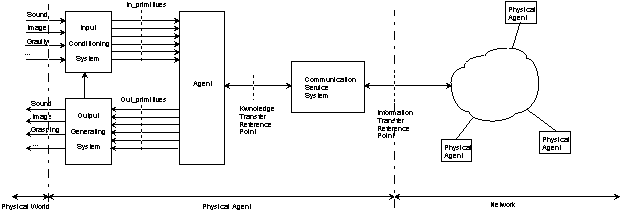
| FIPA | 96/05/22 17:35 |
| FOUNDATION FOR INTELLIGENT PHYSICAL AGENTS | Fipa6504 |
| Source: A. Mamdani |
Draft
Definition of basic agent capability list
Agents, as used in this context, are high-level software entities with defined roles. They interact both with the physical world and each other. We include the humans that are part of this physical world.
Separate technologies have been developed for computing machines to deal with humans and with mechanical machines. Fig. 1 below describes how the FIPA work in the agent field can be visualised.

Fig. 1 - Agent and society of agents
The London meeting (18-19 April) produced a list of 16 basic agent capabilities that participants believed could be the target of a short-term (December 1997) standardisation. Such an assessment did not obviously imply, at that point in time, any judgement on the desirability of nor commitment to standardising any of those items. Steps in that direction will be taken at the next meeting (Yorktown, NY, 24-26 June).
Below is an attempt at defining the 16 items and providing, where helpful, some examples.
Because intelligent agents communicate with humans and speech
technology is well advanced therefore the interface with the
agent is an issue for standardisation. Examples of primitives are
those related with the linguistic, emotional and referential
content.
Visual input encompasses a large number of input possibilities. Substantial technological progress has been achieved. The areas included:
The essence of good human-computer interaction design is to manage the cognitive complexity of the information that is visually conveyed to the user. Many examples can be stated, such as
Visual input is essential for a number of applications. To be sufficiently flexible, the visual input must be controllable from other parts of a system to provide the desired information. Among functions and variables to specify are: control for stereo cameras of version and vergence, separate control of eyes (cameras) and head (combination), ability to perform saccades, fixation and smooth pursuit. These and other control modes allow the system to actively browse the environment, search for objects, make detailed analyses and respond to requests by the system.
This is needed to affect the physical environment. The range of possibilities include grasping and lifting to physical movement.
We do not expect to deal with only one type of input information at a time. Multiple sources of inputs have to be correlated with each other. Fusion can take rather simple forms such as synchronisation of events to complex algorithmic multi-sensor data fusion.
When agents deal with the human part of the physical world then the issue of style becomes important. For example even within a single culture there are different styles when dealing with children or adults. Indeed different language support provide a natural cultural dimension.
Formalised approach for the interchange of knowledge between agent. For example a language based on speech act vocabulary or KIF.
At a lower level of abstraction for interchanging information between agents, various performatives are normally used. KQML is an example of such a set of performatives.
This refers to the composition of basic message types into protocols for agents to cooperate with one another e.g. agents negotiating with each other for optimum use of resources.
Multi-agent systems will be used in a variety of applications that are capable of being classified into two specific types. Standard libraries will help application developers with the necessary implementation tools.
Standard libraries can provide subsets of protocols to support typical applications. Examples are supplied by Web filters, a diary assistant, space planning etc.
Agents will need to represent a large set of agent-linguistic primitives and to make use of this knowledge in scheduling their own task. This representation has some degree of implication on the internal structure of the agent.
These will allow users to speed up development of specific agent applications.
Agent development systems are an important tool for implementing applications. An explicit standardisation may not be strictly necessary but beneficial in the early phases of the industry.
Again a specification of a minimal class can benefit the early phases of industry.
When large number of agents interact with one another then some of the following issues may generate their own scope for standardisation
| Dr. Leonardo Chiariglione | +39 11 228 6129/6116/5111 | |
| Multimedia and Video Services | +39 11 228 6299/6190/5520 | |
| CSELT | leonardo.chiariglione@cselt.it | |
| Via G. Reiss Romoli, 274 | http://www.cselt.it/ufv/leonardo | |
| I-10148 Torino (ITALY) |